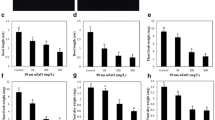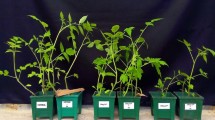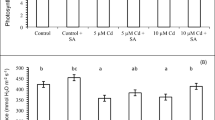Abstract
Triclosan (TCS) is a chlorophenol which is highly bacteriostatic and used in a wide array of consumer products. TCS is now one of the most commonly detected organic pollutants in the sewage sludges. The sludge utilization for fertilizers on agricultural land would pose the risk of causing adverse effects on plant growth and yield by TCS. However, the toxicity of TCS toward plants is comparatively less understood. In this study, we assessed the effects of TCS on tobacco plants which were grown in MS medium or soils containing various concentrations of TCS. Our results indicated that TCS at the concentration of 2 mg/L could strongly inhibit the tobacco seed germination. TCS could suppress tobacco plant growth in soil with different concentrations (10, 20, and 50 mg/kg) of TCS through the downregulation of chlorophyll contents, restricting photosynthesis and increasing generation of reactive oxygen species (ROS). Salicylic acid (SA) plays important roles in the stress response of plants. The role of exogenous SA application in protecting tobacco plants from TCS stress was also investigated in this study. SA application could significantly increase net photosynthesis, enhance antioxidant enzyme activity, and thereby enhancing tobacco plant tolerance to TCS. Moreover, the activation of MPK3 and MPK6 induced by TCS was downregulated in plants with the treatment of SA. It was thus referred that mitogen-activated protein kinases (MAPKs) might play a key role in the signal transduction of TCS stress, and this process might be regulated by SA signaling. Overall, our results demonstrated that TCS had negative impacts on tobacco plants and SA played a protective role on tobacco plants against TCS stress.







Similar content being viewed by others
References
Ahammed GJ, He B, Qian X et al (2017) 24-Epibrassinolide alleviates organic pollutants-retarded root elongation by promoting redox homeostasis and secondary metabolism in Cucumis sativus L. Environ Pollut 229:922–931
Ahammed GJ, Ruan Y-P, Zhou J, Xia XJ, Shi K, Zhou YH, Yu JQ (2013) Brassinosteroid alleviates polychlorinated biphenyls-induced oxidative stress by enhancing antioxidant enzymes activity in tomato. Chemosphere 90:2645–2653
Ahammed GJ, Yuan H-L, Ogweno JO, Zhou YH, Xia XJ, Mao WH, Shi K, Yu JQ (2012) Brassinosteroid alleviates phenanthrene and pyrene phytotoxicity by increasing detoxification activity and photosynthesis in tomato. Chemosphere 86:546–555
Alam MM, Hasanuzzaman M, Nahar K et al (2013) Exogenous salicylic acid ameliorates short-term drought stress in mustard (Brassica juncea L.) seedlings by up-regulating the antioxidant defense and glyoxalase system. Aust J Crop Sci 7:1053–1063
Bigeard J, Colcombet J, Hirt H (2015) Signaling mechanisms in pattern-triggered immunity (PTI). Mol Plant 8:521–539
Chen S, Wu F, Li Y et al (2019) NtMYB4 and NtCHS1 are critical factors in the regulation of flavonoid biosynthesis and are involved in salinity responsiveness. Front Plant Sci 10:178
Das K, Roychoudhury A (2014) Reactive oxygen species (ROS) and response of antioxidants as ROS-scavengers during environmental stress in plants. Front Environ Sci 2:53
Dhillon G, Kaur S, Pulicharla R et al (2015) Triclosan: current status, occurrence, environmental risks and bioaccumulation potential. Int J Environ Res Public Health 12:5657–5684
Fatma F, Kamal A, Srivastava A (2018) Exogenous application of salicylic acid mitigates the toxic effect of pesticides in Vigna radiata (L.) Wilczek. J Plant Growth Regul 37:1185–1194
Genot B, Lang J, Berriri S, Garmier M, Gilard F, Pateyron S, Haustraete K, van der Straeten D, Hirt H, Colcombet J (2017) Constitutively active Arabidopsis MAP kinase 3 triggers defense responses involving salicylic acid and SUMM2 resistance protein. Plant Physiol 174:1238–1249
Guan C, Ji J, Li X, Jin C, Wang G (2016) LcMKK, a MAPK kinase from Lycium chinense, confers cadmium tolerance in transgenic tobacco by transcriptional upregulation of ethylene responsive transcription factor gene. J Genet 95:875–885
Guan C, Ji J, Zhang X, Li X, Jin C, Guan W, Wang G (2015) Positive feedback regulation of a Lycium chinense-derived VDE gene by drought-induced endogenous ABA, and over-expression of this VDE gene improve drought-induced photo-damage in Arabidopsis. J Plant Physiol 175:26–36
Guan C, Song X, Ji J et al (2014) Salicylic acid treatment enhances expression of chalcone isomerase gene and accumulation of corresponding flavonoids during fruit maturation of Lycium chinense. Eur Food Res Technol 239:857–865
Heidler J, Halden RU (2007) Mass balance assessment of triclosan removal during conventional sewage treatment. Chemosphere 66:362–369
Herrero O, Pérez Martín JM, Fernández Freire P et al (2012) Toxicological evaluation of three contaminants of emerging concern by use of the Allium cepa test. Mutat Res 743:20–24
Jiang J, Ma S, Ye N, Jiang M, Cao J, Zhang J (2017) WRKY transcription factors in plant responses to stresses. J Integr Plant Biol 59:86–101
Jiang Y-P, Cheng F, Zhou Y, Xia XJ, Mao WH, Shi K, Chen Z, Yu JQ (2012) Cellular glutathione redox homeostasis plays an important role in the brassinosteroid-induced increase in CO2 assimilation in Cucumis sativus. New Phytol 194:932–943
Khan M, Hamid A, Karim M (1997) Effect of sodium chloride on germination and seedling characters of different types of rice (Oryza sativa L.). J Agron Crop Sci 179:163–169
Khan MIR, Fatma M, Per TS et al (2015) Salicylic acid-induced abiotic stress tolerance and underlying mechanisms in plants. Front Plant Sci 6:462
Khan NA, Syeed S, Masood A et al (2010) Application of salicylic acid increases contents of nutrients and antioxidative metabolism in mungbean and alleviates adverse effects of salinity stress. Int J Plant Biol 1:1–8
Kitajima S, Koyama T, Ohme-Takagi M, Shinshi H, Sato F (2000) Characterization of gene expression of NsERFs, transcription factors of basic PR Genes from Nicotiana sylvestris. Plant Cell Physiol 41:817–824
Kováčik J, Klejdus B, Hedbavny J et al (2009) Salicylic acid alleviates NaCl-induced changes in the metabolism of Matricaria chamomilla plants. Ecotoxicology 18:544–554
Krantev A, Yordanova R, Janda T et al (2008) Treatment with salicylic acid decreases the effect of cadmium on photosynthesis in maize plants. J Plant Physiol 165:920–931
Larkindale J, Huang B (2004) Thermotolerance and antioxidant systems in Agrostis stolonifera: involvement of salicylic acid, abscisic acid, calcium, hydrogen peroxide, and ethylene. J Plant Physiol 161:405–413
Liang L, Lu YL, Yang H (2012) Toxicology of isoproturon to the food crop wheat as affected by salicylic acid. Environ Sci Pollut Res 19:2044–2054
Liu H, Weisman D, Y-b Y et al (2009) An oxidative stress response to polycyclic aromatic hydrocarbon exposure is rapid and complex in Arabidopsis thaliana. Plant Sci 176:375–382
Liu X-M, Kim KE, Kim K-C, Nguyen XC, Han HJ, Jung MS, Kim HS, Kim SH, Park HC, Yun DJ, Chung WS (2010) Cadmium activates Arabidopsis MPK3 and MPK6 via accumulation of reactive oxygen species. Phytochemistry 71:614–618
Macherius A, Eggen T, Lorenz W, Moeder M, Ondruschka J, Reemtsma T (2012) Metabolization of the bacteriostatic agent triclosan in edible plants and its consequences for plant uptake assessment. Environ Sci Technol 46:10797–10804
Maksymiec W, Krupa Z (2006) The effects of short-term exposition to Cd, excess Cu ions and jasmonate on oxidative stress appearing in Arabidopsis thaliana. Environ Exp Bot 57:187–194
Mathews S, Henderson S, Reinhold D (2014) Uptake and accumulation of antimicrobials, triclocarban and triclosan, by food crops in a hydroponic system. Environ Sci Pollut Res 21:6025–6033
Metwally A, Finkemeier I, Georgi M, Dietz KJ (2003) Salicylic acid alleviates the cadmium toxicity in barley seedlings. Plant Physiol 132:272–281
Miguel AS, Faure M, Ravanel P et al (2012) Biological responses of maize (Zea mays) plants exposed to chlorobenzenes. Case study of monochloro-, 1,4-dichloro- and 1,2,4-trichloro-benzenes. Ecotoxicology 21:315–324
Oguntimehin I, Eissa F, Sakugawa H (2010) Negative effects of fluoranthene on the ecophysiology of tomato plants (Lycopersicon esculentum Mill): Fluoranthene mists negatively affected tomato plants. Chemosphere 78:877–884
Pasqualini S, Batini P, Ederli L et al (2001) Effects of short-term ozone fumigation on tobacco plants: response of the scavenging system and expression of the glutathione reductase. Plant Cell Environ 24:245–252
Popova LP, Maslenkova LT, Yordanova RY, Ivanova AP, Krantev AP, Szalai G, Janda T (2009) Exogenous treatment with salicylic acid attenuates cadmium toxicity in pea seedlings. Plant Physiol Biochem 47:224–231
Raja V, Majeed U, Kang H et al (2017) Abiotic stress: interplay between ROS, hormones and MAPKs. Environ Exp Bot 137:142–157
Razinger J, Dermastia M, Koce JD et al (2008) Oxidative stress in duckweed (Lemna minor L.) caused by short-term cadmium exposure. Environ Pollut 153:687–694
Rivas-San Vicente M, Plasencia J (2011) Salicylic acid beyond defence: its role in plant growth and development. J Exp Bot 62:3321–3338
Robert-Seilaniantz A, Grant M, Jones JDG (2011) Hormone crosstalk in plant disease and defense: more than just jasmonate-salicylate antagonism. Annu Rev Phytopathol 49:317–343
Schwitzguébel J-P, Page V, Martins-Dias S, Davies LC, Vasilyeva G, Strijakova E (2011) Using plants to remove foreign compounds from contaminated water and soil. In: Schröder P, Collins CD (eds) Organic Xenobiotics and Plants: From Mode of Action to Ecophysiology. Springer, Dordrecht, pp 149–189. https://doi.org/10.1007/978-90-481-9852-8_8
Shakirova F, Allagulova CR, Maslennikova D et al (2016) Salicylic acid-induced protection against cadmium toxicity in wheat plants. Environ Exp Bot 122:19–28
Stevens KJ, Kim S-Y, Adhikari S et al (2009) Effects of triclosan on seed germination and seedling development of three wetland plants: Sesbania herbacea, Eclipta prostrata, and Bidens frondosa. Environ Toxicol Chem 28:2598–2609
Suzuki N, Koussevitzky S, Mittler R et al (2012) ROS and redox signalling in the response of plants to abiotic stress. Plant Cell Environ 35:259–270
Wang C, Zhang Q (2017) Exogenous salicylic acid alleviates the toxicity of chlorpyrifos in wheat plants (Triticum aestivum). Ecotoxicol Environ Saf 137:218–224
Wang Q, Liang X, Dong Y et al (2013) Effects of exogenous salicylic acid and nitric oxide on physiological characteristics of perennial ryegrass under cadmium stress. J Plant Growth Regul 32:721–731
Wu X, Ernst F, Conkle JL, Gan J (2013) Comparative uptake and translocation of pharmaceutical and personal care products (PPCPs) by common vegetables. Environ Int 60:15–22
Xia X-J, Wang Y-J, Zhou Y-H, Tao Y, Mao WH, Shi K, Asami T, Chen Z, Yu JQ (2009) Reactive oxygen species are involved in brassinosteroid-induced stress tolerance in cucumber. Plant Physiol 150:801–814
Yusuf M, Hasan SA, Ali B, Hayat S, Fariduddin Q, Ahmad A (2008) Effect of salicylic acid on salinity-induced changes in Brassica juncea. J Integr Plant Biol 50:1096–1102
Zhang JJ, Wang YK, Zhou JH, Xie F, Guo QN, Lu FF, Jin SF, Zhu HM, Yang H (2018) Reduced phytotoxicity of propazine on wheat, maize and rapeseed by salicylic acid. Ecotoxicol Environ Saf 162:42–50
Acknowledgments
This work was supported by the National Natural Science Foundation of China (31401391, 31300329).
Author information
Authors and Affiliations
Corresponding author
Ethics declarations
Conflict of interest
The authors declare that they have no conflict of interest.
Additional information
Responsible editor: Gangrong Shi
Publisher’s note
Springer Nature remains neutral with regard to jurisdictional claims in published maps and institutional affiliations.
Electronic supplementary material
ESM 1
(DOCX 403 kb)
Rights and permissions
About this article
Cite this article
Guan, C., Wang, C., Wu, H. et al. Salicylic acid application alleviates the adverse effects of triclosan stress in tobacco plants through the improvement of plant photosynthesis and enhancing antioxidant system. Environ Sci Pollut Res 27, 1359–1372 (2020). https://doi.org/10.1007/s11356-019-06863-8
Received:
Accepted:
Published:
Issue Date:
DOI: https://doi.org/10.1007/s11356-019-06863-8




